It’s been a long, steep, rocky, wet climb up the mountain’s northern shoulder, and now I’m nearing the AMC hut tucked in a col beneath the summit of Mt. Madison. Another 500 feet to go, and I will have completed my quest – to climb all 48 of New Hampshire’s 4,000-footers, and to do so barefoot, which is how I hike and run these days.
July 2018
The journey started 5 years ago as I was planning a visit to the Grand Canyon — and feeling nervous about the 4,000-foot descent from the rim to the Colorado River — and then the climb back out again. I thought of the Presidential Traverse, the 23-mile route across New Hampshire’s tallest mountain range. As a training exercise, it seemed ideal.
At this point in my hiking career, I had some barefoot experience in New York’s Catskill and Adirondack Mountains. But still I felt like a novice. I’d never gone barefoot as a kid. It wasn’t until my early fifties that I started experimenting without shoes. Which is why some preparation seemed prudent before tackling the Grand Canyon. Although I didn’t know much about New Hampshire, besides its nickname, “the Granite State.”
The drive up from New York was long and painful. I pulled into the parking area at Crawford Notch, butt aching from too many jump-squats a few days earlier compounded by five-plus hours in the driver’s seat. The next morning I felt better, but even so my barefoot Presidential traverse started at a crawl, for the trail to Mt. Webster is incredibly steep – it seemed like a crazy staircase built of tumbled blocks of rough stone. Once I gained the ridge, I found the trail strewn with orange-gray granite fragments and chunks of milky quartz. I stepped cautiously on this edgy debris. Moved through the dense boreal forest at a tentative pace. Flushed a spruce grouse, which scurried down the trail.
It would have been nice to go faster, as the weather was a concern — what with thunderstorms in the forecast, and high winds. After four miles, I reached Mitzpah Spring Hut, just as it was starting to drizzle. Inside I found an updated forecast pinned to the wall, which now called for windspeeds of 100 mph. I asked the crew chief for advice. He shrugged. Thunder pealed softly as I exited.
I shuffled anxiously across Eisenhower and then Franklin. In the murky distance, I made out a cluster of buildings and antennae on Mt. Washington’s summit, with sheets of mist tearing through. Finally I spotted the Lake of the Clouds Hut, my destination for the evening. I made it there by late afternoon. The storm hit that evening. The wind raged all night.
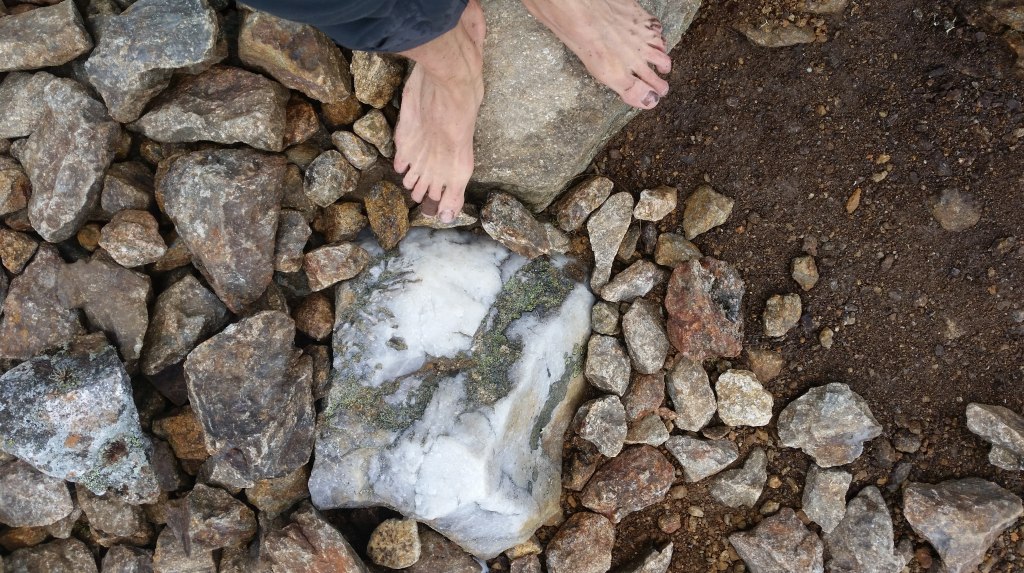

The winds were still howling the next morning, although the sky was clearing, as I crept up towards the summit of Mt. Washington, wearing every scrap of Gore-Tex, wool, and pile in my pack. The trail led through a field of boulders, some of which had smooth faces and were easy to step on. But some of the rocks had sharp-edged wavy ripples, which were uncomfortable. I persevered. Made it to the top. Staggered in the gusts. Looked out onto the immense bulging spine of the range, which rose out of forested depths and rolled north, the whole scene now lit by brilliant sun.
Barefoot hiking in the mountains is a cautious process – on a rocky path, each step must be precise. I was making steady progress, but as morning gave way to afternoon, my concentration began to waver. I scratched the side of a foot against a rock. Caught a toe while stepping over a stone. There were more missteps, each one a small surprise and source of irritation. After hours of concentration, I was becoming fatigued. Starting to feel frustrated. I banged a toe again. Called a “time out.” Drank some water. Studied the map. Counted to ten. And then resumed travel.
It was late afternoon by the time I reached Madison Hut. I looked up wistfully toward the summit, then glanced down at my watch. I’d made arrangements for a car to pick me up at the end of the traverse, down in the valley, four long miles away. This was a commitment I needed to keep. Pulling out a pair of trail-running shoes from the bottom of my pack, I scampered down the mountain and made it to the trailhead with a few minutes to spare. And so, an almost-complete Presidential Traverse was added to my list of barefoot achievements.
Barefoot had started as an experiment. I’d read Chris McDougall’s besteller Born to Run, whose premise is that barefoot running promotes natural form and reduces the risk of injury. I discovered that barefoot was incredibly intense – which made it surprisingly fun. To be sure, not every step was pleasurable, but the contrast between rough (rocks, gravel) and smooth (dirt, mud, grass, moss) was intoxicating. And the extra level of sensation made me feel connected to the land. As if I’d become part of the forest, instead of merely passing through.
Barefoot also offered a connection to the past, since long ago that’s how everyone walked. Even recently, barefoot was common. For example, my great grandmother went around barefoot as a teenager. She was an orphan, and in the Old Country, people did not have extra shoes to share. My ancestors made the decision to emigrate, which was a smart move. They spared their descendants, including me, from a bad scene (persecution, famine, war).
I wonder if I’ll have to make such consequential decisions in my life. Is there some place I should leave?
2020
In 2019 I took on a new job, which didn’t leave time for New Hampshire. But that changed in 2020, when the COVID pandemic struck, and all my business travel was canceled. There was a palpable sense of dread hanging over congested urban areas like New York City. The specter of lockdowns concerned me, as I couldn’t fathom spending summer days indoors. I came up with a plan to escape the malaise, at least for a month, with a thru-hike of the John Muir Trail. Once again, New Hampshire seemed like an ideal training ground, in this case for a shake-out hike to test my camping gear, as well as a chance to toughen up my feet for the Sierra Mountains.
The first weekend in July found me pulling into a parking lot in Lincoln, New Hampshire. After paying for a parking pass and hanging receipt on rearview mirror, I locked my car and set out, initially along a forest road which paralleled the Pemigewasset river. I stepped cautiously on a packed dirt surface sprinkled with sharp gravel. Once atop the crest, there were plenty of granite fragments demanding close attention. But I also found my eye drawn to blooming alpine plants, like Labrador tea with its small white flower clusters. Later that afternoon, after summiting Bond and Bondcliff, I was checking my map for Guyout Campsite, when I encountered a group of young hikers heading to West Bond, which I’d somehow overlooked while planning my route. Eager to add this peak to my list, I dropped pack, scampered after them, and then sat talking at the summit with a young man (he’d completed the 48 twice already and was thinking about the Grid) — until I noticed distant clouds with long graceful tendrils, drifting toward us. I darted back to the trail, secured a spot in the campsite, and got my tent set up quickly.

The next day, I headed off toward Zealand, along the way flushing a spruce grouse, which this time flapped onto a branch directly overhead. Roast grouse, it occurred to me, would have made a tasty dinner — if I’d been carrying a shotgun — or even if I picked up a rock and threw it. But there was no need to hassle the fowl, as my pack held plenty of food.
That afternoon, after summitting Garfield I was marching high above Franconia Notch. The sky was bright, the sun was strong, and I was rationing my single liter of water and wishing I had brought more, while hordes of day hikers streamed up from the valley and milled about. My test hike was nearly complete. Besides a bottle of olive oil which sprang a leak, all my gear had passed muster. I rested for a moment on the summit of Liberty Mountain. Sipped some water. Brushed away flies. Reflected on the date (it was the Fourth of July). Recalled something the Reverend Martin Luther King, Jr. once wrote — “The oppressor never voluntarily gives freedom to the oppressed. You have to work for it.”
It had taken a lot of work to climb these mountains barefoot. In doing so, I’d achieved a sense of freedom — albeit fleeting. I’d escaped from the pandemic for a moment, but would soon return to a world where people clamored for ventilators, lockdowns, school closures, mask and testing mandates, and experimental emergency-use vaccines — every kind of high-tech solution imaginable. Yet relatively few seemed interested in talking about natural options, like diet, exercise, sunlight, and fresh air.
If you want to be healthy and strong, you might have to work for that, too.


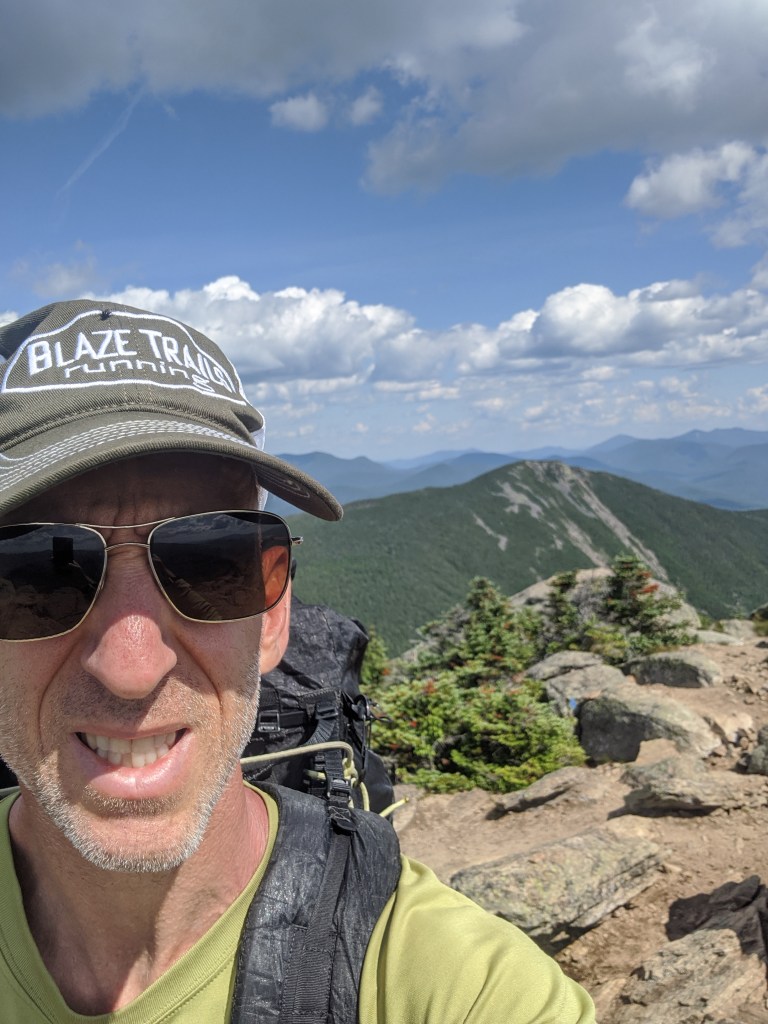
2021
With 21 of the 48 high peaks complete, it would have been quite difficult for me to stop. Peak-bagging appeals to the obsessive side of my personality — the part of me which hungers for the dopamine hit that comes from checking off a task. Though, honestly, that’s mostly rationalization. As I’ve gotten older, the need to escape from computers, video calls, social media, and even old-fashioned paperwork — the need to escape from technology itself — and spend more time in nature has become increasingly intense. It’s not that I’m against technology — it’s just that too much weighs me down. In the way that Earl Schaeffer, the first person to thru-hike the Appalachian Trail, advised — “carry as little as possible, but choose that little with care.”
Although nature is not without its challenges. Early October found me making the steep climb (average grade 38%) to Wildcat. This time butt was OK, but knees complained the whole way up. On the far side, the stone steps were spaced just the right distance apart for me to bound down, knees happy, into the dense fog shrouding Carter Notch. I passed a pond whose dark waters reflected the sallow hue of autumnal beech. Then swung open the door to Carter Notch Hut and marched in.

It was warm inside. Crowded. Noisy. I got a cup of hot water and sat down at a table to fix a cup of tea, when a young man with a bushy black beard joined me. Earl explained that he was hiking the Appalachian Trail to raise awareness about veteran suicide. I wanted to ask him, why are service members so despondent? – when a heavyset woman sidled over. She introduced herself as a healthcare worker and asked about our plans, but what she really wanted to know was our vaccination status. The conversation became tense. Earl was sitting there silently, but with an eyebrow raised, when another woman interrupted. Explained she was a neuroscientist, that she had taken the vaccine but did not believe it stopped the spread. She did not trust big pharma. She didn’t like doctors either – she’d gone to a series of them complaining of a stomach ailment, and all they did was prescribe anti-depressants – “because I’m a woman and that’s how they treat us.”
I excused myself and retreated to my bunk. The pandemic was still ongoing, and it occurred to me that these people had been breathing in my face all evening. The next morning, I was up and out of there before breakfast.
I walked slowly, all day, in rain and mist. Passed through a forest of tangled spruce and fir trees, sprouting from impossibly steep slopes, trunks draped with beard lichen, branches festooned with puffs of silver and pale green. The lumpy ground and wood debris — covered in lush lime-green moss and tiny pixie cups with red fruiting bodies. Mushrooms bursting from the leaves. Orange, yellow, brown, black, and ghoulish white — the colors of Halloween. This is their world. I am merely a visitor, passing through. Stepping on wet leaves, slick and cool.
I reached a tent site. Fixed my dehydrated meal. Sat there eating it in the rain.
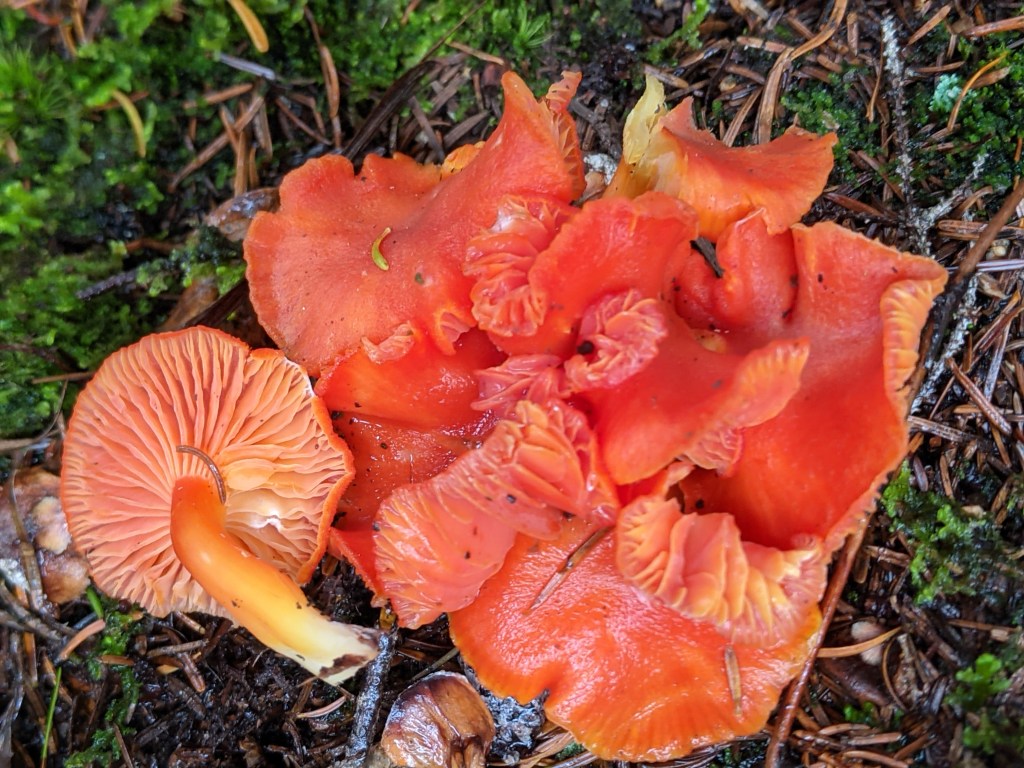

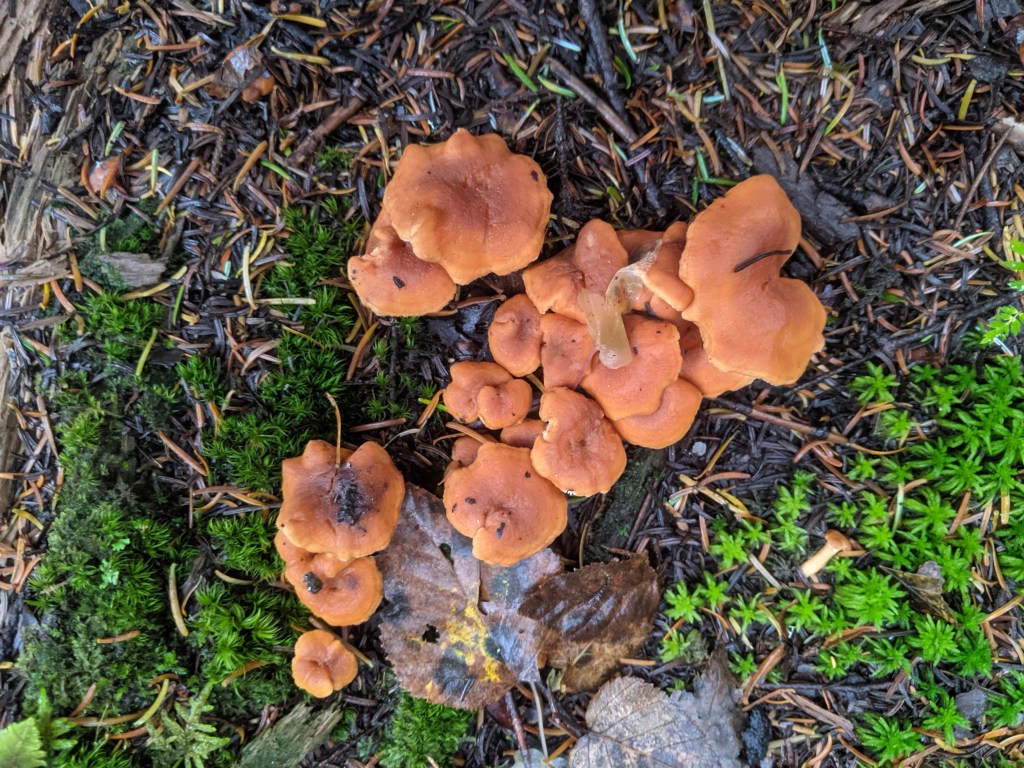

The next day I made the long descent into the town of Gorham. Padded across exposed granite slabs covered with bright puffy clumps of reindeer moss, so springy underfoot, mixed with berry heather turning bronze and sprigs of fir or yew. Red maple leaves lay upon the damp earth, flashing like rubies. Then it was into piles of beech nut husks and acorns, which were vaguely annoying under foot. The fog broke apart, and to the north and west I glimpsed mountains dotted with wind turbines, long white blades motionless. The grade eased. The sounds of traffic echoed in the woods.

Earl had told me of a coffee shop in town, although he cautioned it was a “peculiar” place. So now I stopped by for a dose of caffeine before the long drive home, and he was right — the place had a weird vibe. Propped on the counter was a small painting with four figures, the villains from popular horror movies, and a legend – “put your mask on, we’re going killing.” Which seemed an odd statement to make during a pandemic. I was going to comment, but decided to keep my opinions to myself when I noticed one of the patrons had a small black handgun on his belt. Driving out of town, I passed a lawn sign that read “F*ck Joe Biden, and F*CK YOU for voting for him.”
After hours of incessant rain, I made it home to New York, where people don’t open carry or make snarky comments about masks. Although that doesn’t mean they’re nicer.

June 2022
Once again I’m heading to New Hampshire. This time I’m here to push boundaries. See what I can still do.
There’s no telling how long the 18-mile round trip to Owl’s Head might take without shoes, so I toss a headlamp in my pack. But the trails are damp and soft. In some places I’m practically running. I pause at Black Pond as rain flickers across the lacquered surface. Later I’m muscling up the steep rock slide that leads to the summit. Placing soft wet feet — with care — on wet, sharp-angled granite blocks doused with sand and grit. I miss a turn on the way down, check GPS, reorient, dance down a steep slope so thickly covered in fir needles and moss it’s like bouncing on a sponge.
On the hike up North Hancock, the knees are fine. Until a few steps before the summit, when the right one starts pinging. I tread carefully across the saddle (such as lovely flat trail) to South Hancock, where I startle a family eating lunch (they didn’t hear me coming). “You weren’t pulling 360-degree security,” I observe (admittedly a cryptic comment, but that’s what popped into my head). Debbie, Mike and their teenage sons are working on the 48. Debbie’s surprised to learn I’ve been hiking all day without shoes. “May I tell you how impressed I am?” With some hesitation, I allow she may.
I leave the family to finish lunch and head down a steep trail liberally strewn with sand and rocks. To keep torque off the right knee, I lower myself down each step mainly with my left leg, extending right foot gingerly in search of soft landing. The family catches me a little later and moves ahead. By coincidence, we find ourselves later that evening eating dinner at the same restaurant. Debbie asks what I carry in my pack for food (after a metabolic diagnosis, she changed her diet and lost a lot of weight). To which I reply that typically I hike in a fasted state.
On the summit of Moosilauke, I stand up and walk a few paces, pat my pocket to check for reading glasses, discover they’ve fallen out. Feel old and stupid. Later I encounter Betsy, who looks 50, but she tells me she’s been hiking in the Whites for 70 years.
The last hike of the trip is the two Kinsmans. This is a difficult trail, full of boulders. Up ahead I hear a shout. I recognize the tone — that familiar mix of surprise, frustration, and indignation. It’s Russ. A heavy-set man wearing tan pants, green shirt soaked with sweat, a big pack. “I slipped back there,” he explains. Then clarifies — “I fell.”
From the straggly white hair, I place Rush in his 70s. In between grunts I learn that many years ago he thru-hiked the Appalachian Trail. Now he’s section-hiking it. When he turns to talk, I see there is a small cut on his forehead.
At the summit of South Kinsman, we part ways, as Russ is going on (he’s on the last leg of his section hike), while I’m turning back. I congratulate him on being so close to his goal and ask what’s next. He replies, “That’s it. I’m kaput.”
On the way back I pause on a ledge which overlooks the valley. To my left is Cannon Mountain, which I’d hoped to climb today, but I’ve run out of time. Overhead I spot a glider. It circles slowly. Yaws slightly. Drifts. It occurs to me that all journeys must come to an end. But if you catch a thermal, the trip might be longer and more interesting than you imagined.
On the long drive home, I pass red barns, white farmhouses, fat cows attentive to the grass in the golden light of late afternoon. The Bennington Battle Monument in southern Vermont stands out in the gathering dusk. I dance on down the road into New York, where I break for food on the outskirts of Troy. As I’m eating my hamburger a stratus cloud drifts languidly overhead, tinged salmon and dull purple, the colors of an agitated octopus. And then it’s into fog so thick I need to use the windshield wipers.

June 2023
Today it feels like I have arrived. For the trails flow by with hardly any effort. The sky is misty, the air moist, the dirt is damp and soft. Butt and knees seem OK, and the climbs up Waumbek, Cabot, and Tom do not faze me. Naked feet on mountain trails at a pace that, if not fast, is steady and sustainable. The original human mindfulness. Unlike the out-of-control acceleration of technology and the frantic hope that it will produce a better life, if it doesn’t first destroy us.
On the way to Cannon Mountain under pewter skies, I see bright pink eyes blinking– rhodora and swamp laurel blooming alongside Lonesome Lake — and then I spot a ghostly white lady slipper sprouting by the trail — while the wet woods ring with the cries of black-throated green and blue warblers. I pause at the summit, endure wind-lashed rain, ride the tramway down, and stroll back to my car on a wet bicycle trail.

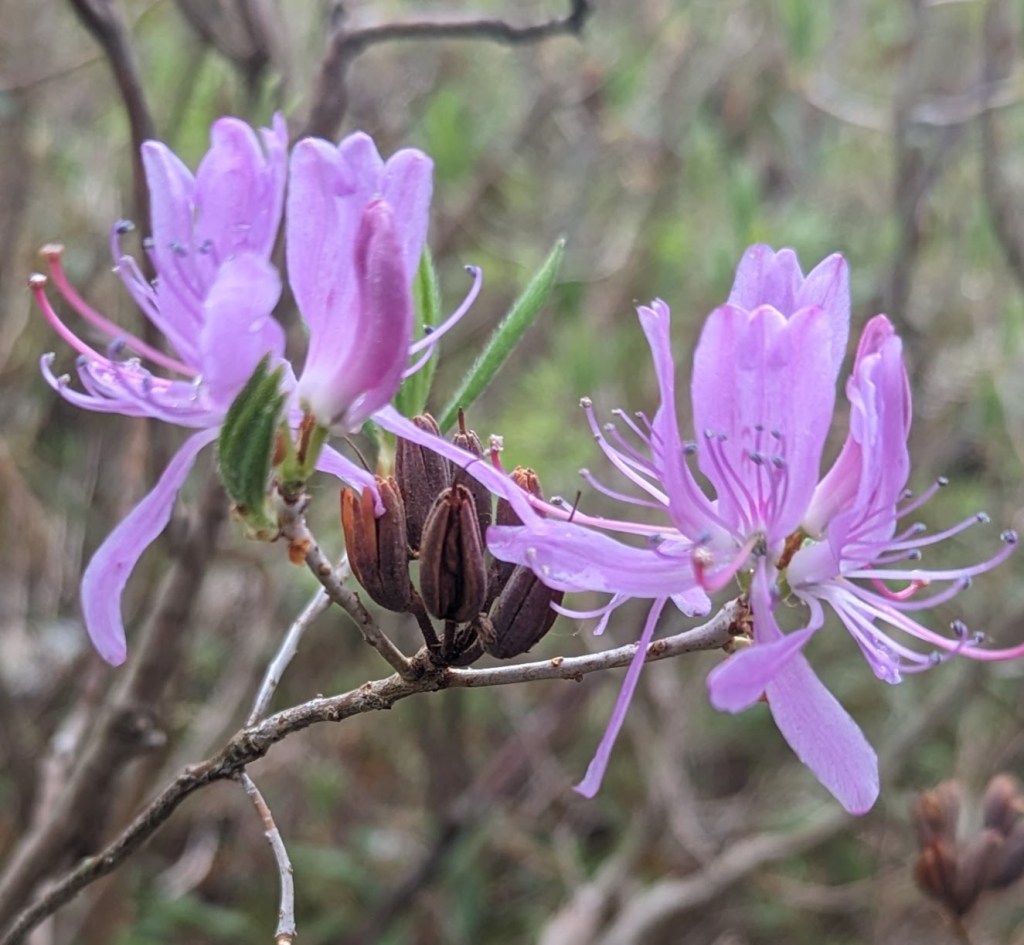

The rain abates. The atmosphere is moody with watery sunlight and churning haze and clouds of mosquitoes and biting flies. The 11-mile loop over Whiteface and Passaconaway takes all day, but the scrambles are fun, and the vistas from Blueberry Ledge — of huge green round ridges and vast blue mountainscapes — are spectacular.
The next day is heavy rain — I shelter in a motel room. The day after that, I bag Mt. Hale and then point myself home. On the highway again, I study clouds with hanging tendrils, dragging across the slate-green land, as if probing – then I’m barreling through a spattering, brief but hard — and trying not to lose myself in the highway’s grassy margins. For there’s a splash of yellow (buttercups) — pink froth (ragged robin) — a hillside washed in deep blue (lupines) — waves of white (Queen Anne’s lace and a touch of bedstraw beginning to bloom). Here’s a patch of sweet yellow clover, knee-high, bringing back memories from a prior visit, later in the summer, when it was nearly overhead and mixed with the lemon-colored umbels of wild parsnip.
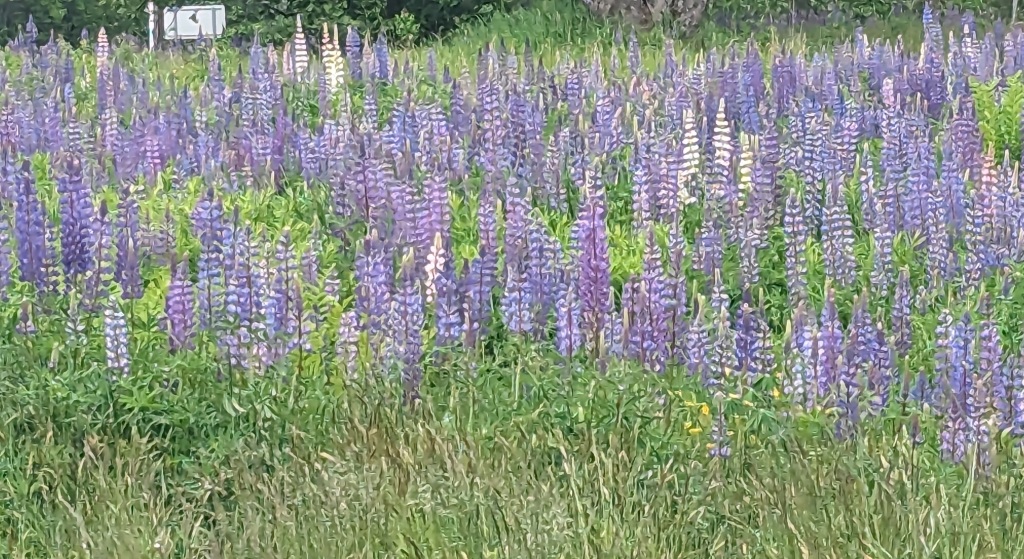
July 2023 — Madison
It occurs to me, on the way to Madison, that you may leave one place behind. But so long as you keep moving, you never arrive. Unless you consider constant movement to be a kind of place.
Today is July 4. Almost 5 years to the day since I started this journey.
I notice dainty white flower-clusters of Labrador tea, but don’t pause to admire them — not with thunderstorms in the forecast. Instead I fly past the AMC Hut tucked in the col — and keep on trucking toward the top of my 48th New Hampshire peak, snaking my way through a steep tumble of gnarled granite boulders, the way marked with a series of grim cairns pointing into clouds. Including the Catskills (which I’ve done over and over again) and the Adirondacks, this will be my 304th barefoot ascent. Not counting Mt. Whitney, which I’ve done twice barefoot, as part of the John Muir Trail. Including these and other hikes, runs and races, and sometimes just walking around town, my training log shows over 10,800 barefoot miles over the last ten years.
Each of these miles was comprised of thousands of steps. Each step was a chance to appreciate damp, tangled forest. Vast blue skies. Granite chips and broken twigs and spruce cones. Birds and flowers and insects and fellow human travelers encountered along the way. Each step was a connection between bone, muscle, sinew, mind — and nature. Each of these connections intermediated solely by the skin of my feet.
Soon it will be time for the long drive home, and then I’ll plug back into the network.
But I feel good. I’d like to cover a few more miles, and climb a few more peaks, while I’m able.


Major congratulations on your accomplishment! (And awesome flower & fungi photos along the way 🙂 ) Cheers, Thea
LikeLiked by 1 person
Thank you Thea 🙂
LikeLike
Congrats, Ken!
LikeLiked by 1 person
Thank you Tony. Always nice to hear from you
LikeLike
Well I’m floored! Congrats on completing all 48 four-thousand foot peaks! My husband and I hike in NH quite often (Canadians) and this past June I did the Presidential Traverse solo. Had despicable weather (which I secretly loved…until it became too much) and it took me 2 days instead of 1 as I bonked my head on a boulder. BUT BAREFOOT??? I have done a lot in my life but am in complete awe! This is awesome! I’m also from the running scene so am familiar with barefoot running, but I have never, ever, in all my mountain pursuits known anyone to do these barefoot!! Just so cool!
LikeLiked by 1 person
Delighted! Barefoot = natural, natural = cool <– that's sort of the whole point. Sorry to hear about your head — I am very respectful of Weather in the Whites at all times of year. Thank you for visiting!
LikeLike
I Googled barefoot Presidential traverse because I want to try it next year (2024) and your blog came up. I’m excited to see that you did it because it gives me confidence to try. I have been barefoot hiking in Southern Maine all summer and absolutely love it. I have 3 trails left to complete all trails in the White Mountain Guide, and I plan to do my final 2 barefoot. Not sure how safe it will be doing the Great Gulf headwall. Maybe I’ll bring my shoes just in case. Congrats Ken! You definitely inspired me.
LikeLiked by 1 person
Hi Michelle, I was just up in Maine barefooting the 4,000-footers — I’m sorry we didn’t cross paths. You can definitely do the Traverse, just be mindful that the weather can be dangerous even in July. I always carry shoes for back up. I hope to follow your adventures, too!
LikeLike
[…] in New Hampshire, which completed my quest to barefoot all 48 of the Granite State’s 4,000-footers. Except that when I got to the summit of Cannon Mountain, it was pouring rain. So I took the […]
LikeLike